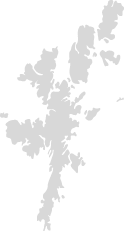Published: 21 February 2018
Knitting tip - thumbs
 50 Tips from Shetland Knitters was made primarly in order to demonstrate things which knitters will find useful but are very difficult to explain in words and photos.
50 Tips from Shetland Knitters was made primarly in order to demonstrate things which knitters will find useful but are very difficult to explain in words and photos.
I have many tasks to catch up with so I have avoided starting a large knitting project - but somehow I have managed to crochet a top for myself and have knitted a few pairs of gloves and handwarmers. The crochet consisted of squares which I joined as I went, so it was handy to pick up when I relaxed in front of the TV, but not interesting enough to keep me from doing other things. The gloves and handwarmers are small projects which are great for experimenting with colour and different ways of approaching thumbs and fingers. When making "50 Tips", Elizabeth showed me how to neatly start fingers (tip 38, if you already have the download/DVD) so I've watched a few times - need some more practice before what to do comes automatically.
Today I was looking at thumbs and realised that a series of photos may be helpful for knitters. When I was growing up I didn't often see fair isle gloves with thumb gussets - but that's probably because most I saw had single colour thumb and fingers. I have been told that shaped thumb gussets were knitted only when the fingers would also be knitted with 2 colours in every round, whereas the gloves which would have single colour fingers had all the extra stitches increased immediately after the cuff.
There are different ways to make a thumb opening.
- You can slip the thumb stitches on to a length of waste yarn or put them on a safety pin or small stitch holder, then cast on stitches to complete the remainder of the palm. In this way you get the thumb opening immediately but casting on stitches makes this area a little more bulky.
- I prefer to knit the thumb stitches with a piece of contrasting yarn, then slip them back to the left needle before proceeding. Usually I knit the stitches above the waste yarn in the background colour, catching the pattern colour on alternate stitches. Recently I picked up a tip from another knitter - immediately after knitting the stitches over the waste yarn stitches, use a thin blunt needle to pass a thread through the newly knitted stitches. When you are ready to knit the thumb, the first step is to pass a knitting needle through the stitches below the waste yarn. When you remove the waste yarn the stitches at the top are already caught on the thread. You can open the thumb before finishing the glove/handwarmer/mitten so you can try it on to check for size.
- If you have progressed a few rows beyond where you want the thumb and don't want to undo your work, it is possible to undo the just thumb stitches to the correct place, knit the stitches with waste yarn then re-knit row by row. However I find it easier do this stitch by stitch. I undo the first stitch to the right place, knit it in waste yarn, then re-work that one stitch column. Sometimes it's possible to store the colours on the left needle as you unpick so they are ready to be re-worked in the correct sequence. Repeat for the other thumb stitches. I think I am straying into the territory of it would be easier to show on film!
- The least favoured method is used only when I have completely forgotten to mark the thumb opening. When ready to knit the thumb, decide which row will be opened. Mark the centre stitch, then pass a thread through the thumb stitches just above that row. 2 rows below you can either pass a thread through the stitches or just leave them alone (works fine when using Shetland wool). Use sharp scissors to cut the centre (marked) stitch, then carefully undo the stitches left and right. This gives very short ends to weave in and is the least satisfactory method to use. However it is quicker than undoing.
Subscribe for Updates
Enter your email address to receive updates from hazeltindall.com in your inbox...
About Shetland

Shetland is the most northerly group of Scottish islands. Apart from mainland Scotland, the other near neighbours are Norway to the east and the Faroe Islands to the north west.











